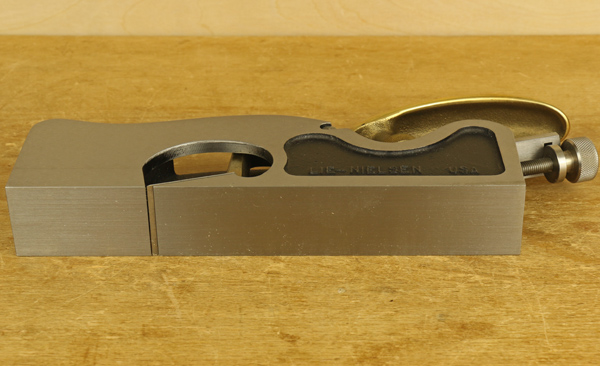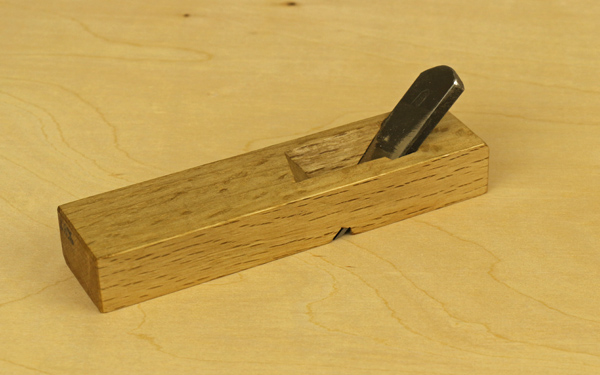A shoulder plane is a versatile tool that allows you to tweak joinery to produce precise fits that will raise the quality of your woodwork. Read on to learn about the different types of shoulder planes available, what to look for when choosing one, and how to use them.

Anatomy and types of shoulder planes
These planes generally range from about 5 to 9 inches long and 1/2 to 1 1/4 inches wide. The key features are flat sides that are accurately square to the sole, and a blade edge that extends the full width of the sole. There is no land of the sole on the sides of the blade like on a bench plane. This permits cutting fully into the junction of an inner corner such as in a tenon shoulder.

In most modern, all-metal versions, the blade is bedded bevel up at 15 – 18 degrees and the edge presents at 90 degrees to the length of the plane. Excellent examples are those by Lie-Nielsen and Veritas. Though not essential, Japanese and some vintage infill shoulder planes have a skewed blade, a feature that can make it easier to start and control cuts, and performs well on end grain, though it is more finicky to sharpen.
There are also modern versions with bodies that are mostly or all wooden. In the Western style, HNT Gordon makes excellent such planes. Japanese shoulder planes also, of course, have wooden bodies and are used on the pull stroke.


Cutting depth on a shoulder plane is adjusted by a screw feed mechanism (Lie-Nielsen, Veritas) or by tapping (Japanese, Gordon). The blade edge of a shoulder plane must fully extend to the side, perhaps even a hair’s breadth beyond, so that the cut can fully extend into an inside corner. This adjustment, along with aligning the edge parallel to the sole, is done by tapping on almost all shoulder planes.
The mouth of these planes must be very narrow. This is adjustable on most all-metal styles, while wooden or non-adjustable metal versions have a narrow mouth built in.
Why you should be using a shoulder plane
Whether you are a primarily machine or hand-tool woodworker, it is essential to have precision incremental techniques to fine tune joinery. Using a plane, you can remove wood in a highly controlled, predictable manner in increments of only one or two thousandths of an inch and maintain the trueness of mating surfaces. This often must be done on inside corners.
No joint cutting process is perfect, and you do not want to default into mediocre joinery. That’s why you should be using a shoulder plane!

Examples of uses
There is no other practical way to perform the essential task of trimming tenon shoulders so they precisely meet the mortise piece for neatness and strength. The shoulder plane is used on its side, as shown below. Some sort of backing, here, a dedicated jig, is used at the end of the cut to prevent grain breakout. Larger shoulder planes are also suitable for trimming the cheeks of tenons.

Similarly, rabbets, whether made with a router or by hand with a rabbet or moving fillister plane, often require adjustment to make a mating piece fit neatly. The shoulder plane is used on its side or vertically, as needed, to cut along or across the grain.

Equally important, there will be numerous other occasions where a sliver of wood makes all the difference. Some examples from my work that come to mind include trimming an installed drawer stop, fitting a drawer bottom into its grooves in the sides and front, fitting a wide stub tenon in a bed headboard, and fitting a web frame inside a cabinet.
The shoulder plane is not for making these joints, it for refining them. You’ll be glad you have this tool when you need it.
Technique for using a shoulder plane
Shoulder planes, with very few exceptions, do not have handles, so you need to come to peace with the tool by experimenting to find an effective, comfortable grip.
I like to wrap my hand around the tool and get my fingers in the spaces so I can apply pressure where it’s needed and keep the plane stable.
For example, when using the plane on its side (its more common orientation) to trim a tenon shoulder, I start by applying lateral pressure to keep the front of the sole firmly against the shoulder. As the cut proceeds, I place lateral pressure over the blade and then on the rear of the sole. I think of trying to keep the corner of the blade against the inside corner of the workpiece.
In the vertical orientation, avoid tipping the plane out of square.
The blade must be very sharp if a shoulder plane is to be effective. A honing guide is helpful for sharpening since the edge should be as square to the length as possible.
Choosing a shoulder plane
OK, you need one, but which one? For most woodworkers looking for a single, general use shoulder plane, I recommend an all-metal version, which is the easiest to adjust, about 7″ long and 3/4″ wide. This will have sufficient mass for stable cutting without being unwieldy for smaller work. Buy the best quality you can afford and be certain that the sides are exactly square to the sole, knowing that this will remain constant in a metal plane but is nearly impossible for you to alter if it is not accurate to begin with.
An alternative is a mid-sized Japanese wooden version. This type usually comes with an excellent quality blade, and the body can be easily adjusted for square.
Bull nose shoulder planes are available with a removable toe to convert it into a chisel plane. This allows work into tight spaces such as a stopped rabbet. This is a less essential tool. I find that a paring chisel can usually do just as well.
FREE woodworking class!
Learn cabinetry essentials and gain the skills you need to tackle your own build in the FREE mini-class Cabinetry Tips & Techniques, brought to you in partnership with WOOD® magazine!
What makes online Bluprint classes great?

Learn for life! With lifetime access to your classes, you can watch lessons at your preferred pace and easily revisit your favorite concepts with just a click.

Kick up your feet! Enjoy classes anytime from the convenience of your home or even on-the-go with our mobile apps.

Get personalized guidance! Ask your fellow students questions to receive all the answers and feedback you need to succeed.

Love it! There’s no risk in trying when it’s free.


Share tips, start a discussion or ask one of our experts or other students a question.
No Responses to “A Look at Shoulder Planes and Why You Need One”